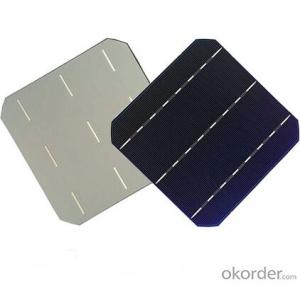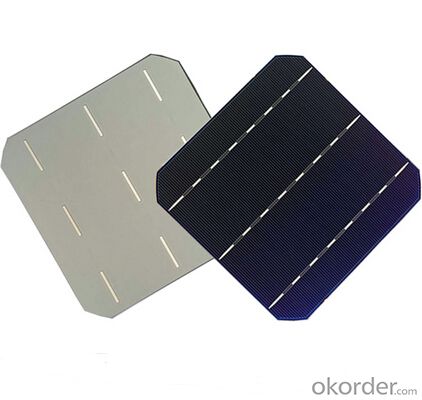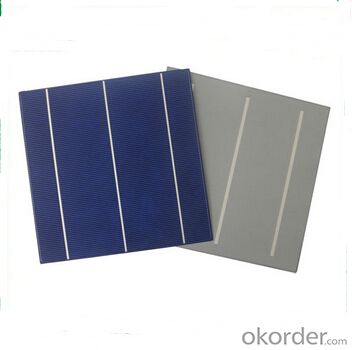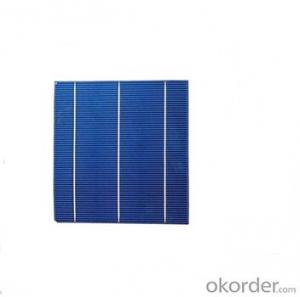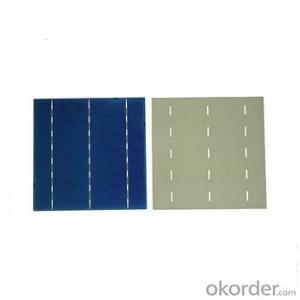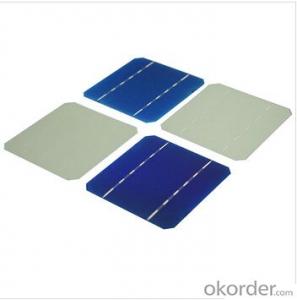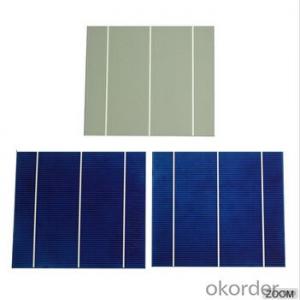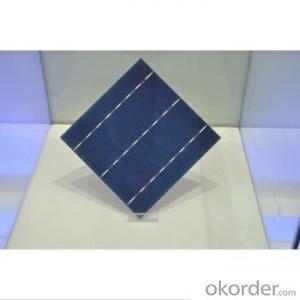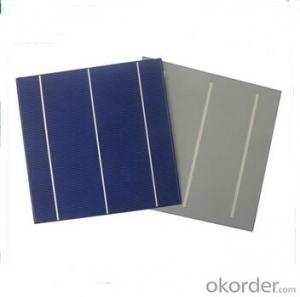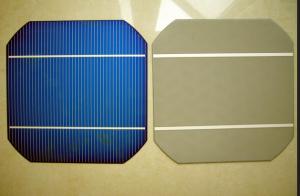3 X 6 Polycrystalline Solar Cells High Quality 17.20%-17.40% Effy
- Loading Port:
- Shanghai
- Payment Terms:
- TT OR LC
- Min Order Qty:
- 1000 pc
- Supply Capability:
- 1000000 pc/month
OKorder Service Pledge
OKorder Financial Service
You Might Also Like
Solar Cells:
Solar cells is made by solar wafer, it has three categories of solar cell right now, monocrystalline polycrystalline and thin film,These cells are entirely based around the concept of PN junction, which is the critical part of solar module, it is the part that can convert the light energy into electricity, the thickness is from 180um to 200um, with even busbars to conduct electricity, textured cell can decrease diffuse reflection; they are often electrically connected and encapsulated as a module. Photovoltaic modules often have a sheet of glass on the front (sun up) side, allowing light to pass while protecting semiconductor wafers from abrasion and impact due to wind-driven debris, rain, hail, etc. Solar cells are also usually connected in series in modules, creating an additive voltage. Connecting cells in parallel will yield a higher current;With high quality and stable quality. Our Cells can greatly improve the performance of Solar Modules.
Solar Cells Advantage:
• High efficiency and stable performance in photovoltaic conversion.
• Advanced diffusion technique ensuring the homogeneity of energy conversion efficiency of the cell.
• Advanced PECVD film forming, providing a dark blue silicon nitride anti-reflection film of homogenous color and attractive appearance.
• High quality metal paste for back surface and electrode, ensuring good conductivity, high pulling strength and ease of soldering.
• High precision patterning using screen printing, ensuring accurate busbar location for ease with automatic soldering a laser cutting.
Specifications
Efficiency Code | 172 | 170 | 168 | 166 | 164 | 162 | 160 |
Efficiency Eff(%) | 17.20-17.40 | 17.00-17.20 | 16.80-17.00 | 16.60-16.80 | 16.40-16.60 | 16.20-16.40 | 16.00-16.20 |
Power Ppm(w) | >4.18 | 4.137-4.186 | 4.088-4.137 | 4.040-4.088 | 3.991-4.040 | 3.942-3.991 | 3.894-3.942 |
Max.Power current Ipm(A) | 7.94 | 7.91 | 7.82 | 7.77 | 7.72 | 7.67 | 7.62 |
Min.Power Current Ipm(A) | 7.73 | 7.68 | 7.58 | 7.54 | 7.49 | 7.44 | 7.39 |
Short Circuit Current Isc(A) | 8.515 | 8.40 | 8.34 | 8.30 | 8.25 | 8.21 | 8.15 |
Max Power Voltage Vpm(V) | 0.522 | 0.520 | 0.519 | 0.516 | 0.513 | 0.511 | 0.508 |
Open Circuit Voltage Voc(V) | 0.624 | 0.622 | 0.620 | 0.618 | 0.616 | 0.614 | 0.612 |
Features:
High efficiencies up to 16.4%
Proven long term mechanical stability of silicone
Make of highly purified poly silicone
Three bus bars for reduced series resistance and improved module and cell efficiency
Blue anti-reflecting coating ensures improved light absorption and increased efficiency
Acid texturization offers a uniform appearance and virtually invisible crystal structure
Excellent low light behavior for improved energy yield
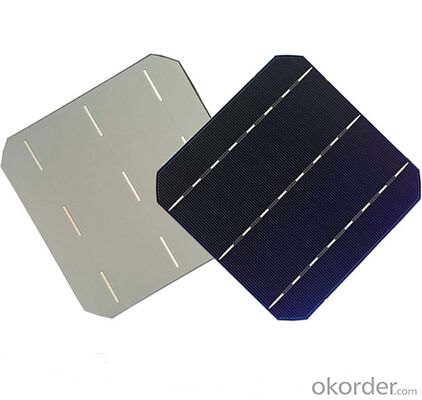
FAQ
We have organized several common questions for our clients,may help you sincerely:
①What price for each watt?
It depends on the efficiency of the solar cell, quantity, delivery date and payment terms.
②How long can we receive the product after purchase?
In the purchase of product within three working days, We will arrange the factory delivery as soon as possible. The pecific time of receiving is related to the state and position of customers.Commonly 7 to 10 working days can be served.
③Can you provide the peripheral products of the solar panels, such as the battery, controller, and inverter? If so, can you tell me how do they match each other?
Yes, we can, we have two companies for solar region, one is CNBM International, the other is CNBM engineering Co.
We can provide you not only the solar module but also the off grid solar system, we can also provide you service with on grid plant.
④What is your warranty of solar cell?
Our product can promise lower than 0.3% open box crack, we support claim after opening the box if it has crackm color difference or sth, the buyer should give pictures immediately, we can not accept the claim after the solar cell has assembled to solar panel.
• Timeliness of delivery
• ⑤How do you pack your products?
We have rich experience on how to pack the solar cell to make sure the safety on shipment, we could use wooden box or pallet as buyer's preference.
- Q: How do solar cells handle snow or ice buildup?
- Solar cells are designed to handle snow or ice buildup by being installed at an angle, which allows for the snow or ice to slide off. Additionally, the dark surface of solar cells tends to absorb sunlight and heat, which can help melt any accumulated snow or ice.
- Q: What is the maximum efficiency possible for a solar cell?
- The maximum efficiency possible for a solar cell, based on current technology, is around 44%.
- Q: Which Solar Panel Type is best? Polycrystalline panel or PV Module Monocrystalline Solar cell panel, or thin film?
- Monocrystalline silicon solar panels are space-efficient. Monocrystalline solar panels produce up to four times the amount of electricity as thin-film solar panels.
- Q: Can solar cells be used in space stations?
- Yes, solar cells can be used in space stations. In fact, they are extensively used to generate electricity in space stations such as the International Space Station (ISS). Solar cells capture sunlight and convert it into electricity, providing a reliable and sustainable source of power for various systems and experiments onboard the space station.
- Q: Can solar cells be installed on curved surfaces?
- Yes, solar cells can be installed on curved surfaces. Flexible solar panels and technologies like thin-film solar cells allow for installation on various curved surfaces such as vehicles, buildings, and even clothing.
- Q: How do solar cells affect the local ecosystem?
- Solar cells have a minimal impact on the local ecosystem compared to traditional energy sources. They produce clean and renewable electricity, reducing the reliance on fossil fuels and their associated pollution. While the manufacturing and disposal of solar cells may have some environmental impact, it is far outweighed by the benefits of using solar energy, such as reduced greenhouse gas emissions and improved air and water quality. Additionally, solar installations can provide habitat for certain wildlife species and contribute to the preservation of natural landscapes. Overall, solar cells have a positive effect on the local ecosystem by promoting sustainability and mitigating climate change.
- Q: Can solar cells be used for powering desalination plants?
- Yes, solar cells can be used for powering desalination plants. Solar energy can be converted into electricity through solar cells, which can then be used to power the various processes involved in desalination, such as pumping water, filtering, and removing salt. This renewable energy source offers a sustainable and environmentally friendly solution for powering desalination plants, reducing the reliance on fossil fuels and minimizing carbon emissions.
- Q: How do solar cells impact energy poverty?
- Solar cells can greatly alleviate energy poverty by providing access to clean and affordable electricity to communities without reliable power grids. Solar energy is a sustainable and renewable source that can be harnessed even in remote areas, reducing dependence on fossil fuels and expensive fuel imports. This technology empowers individuals and businesses to generate their own electricity, improving quality of life, supporting economic development, and enabling access to essential services such as lighting, education, healthcare, and communication.
- Q: How much space is required to install solar cells?
- The amount of space required to install solar cells can vary depending on factors such as the size and efficiency of the solar panels, the energy needs of the property, and the available sunlight. Generally, a typical solar panel requires about 100 square feet of space, but it can vary significantly based on individual circumstances and requirements.
- Q: How can I describe solar cells in a simple way?
- Solar cell is a battery which you can use without damaging our environment.
Send your message to us
3 X 6 Polycrystalline Solar Cells High Quality 17.20%-17.40% Effy
- Loading Port:
- Shanghai
- Payment Terms:
- TT OR LC
- Min Order Qty:
- 1000 pc
- Supply Capability:
- 1000000 pc/month
OKorder Service Pledge
OKorder Financial Service
Similar products
Hot products
Hot Searches
Related keywords
